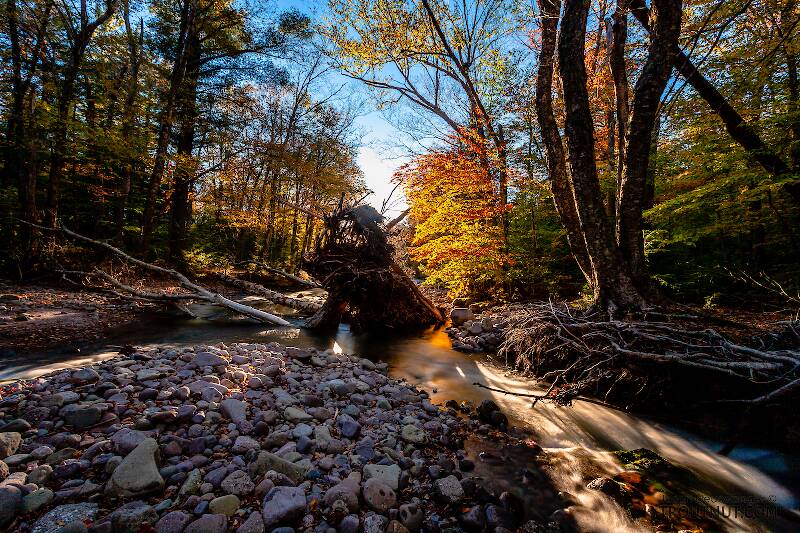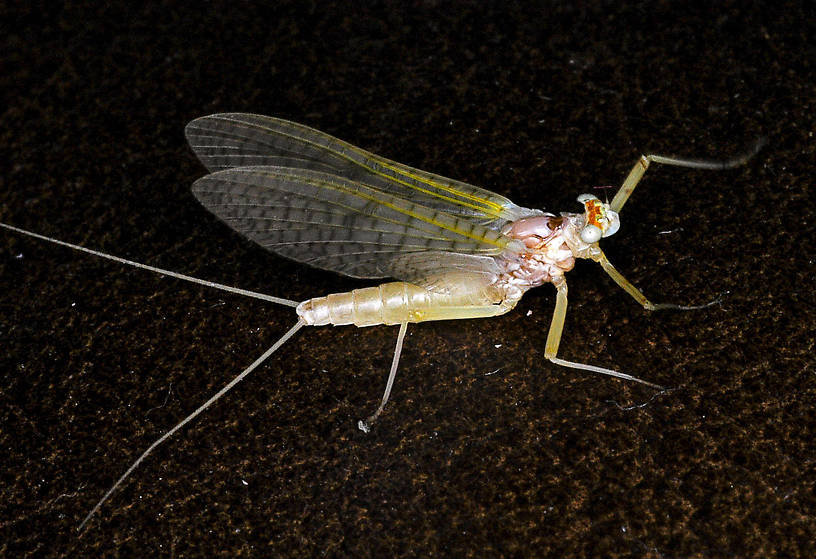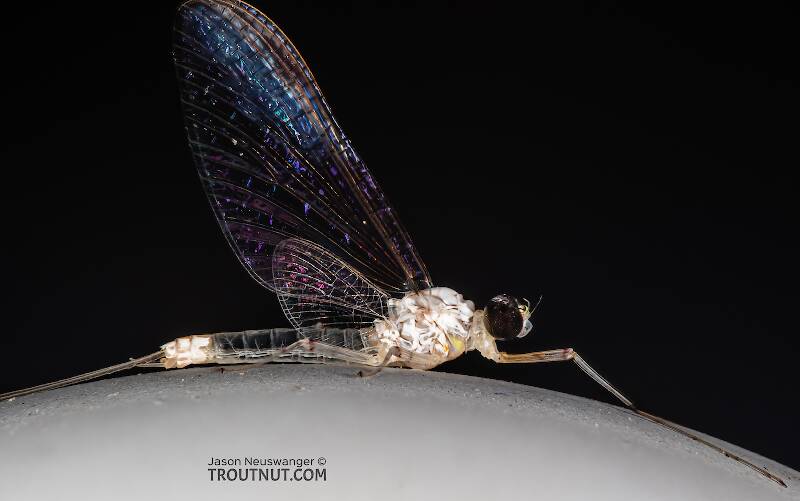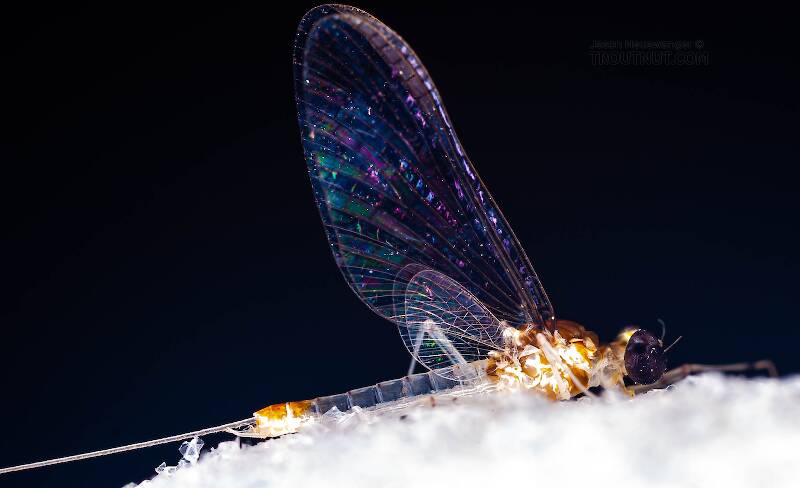
Hex Mayflies
Hexagenia limbata
The famous nocturnal Hex hatch of the Midwest (and a few other lucky locations) stirs to the surface mythically large brown trout that only touch streamers for the rest of the year.

Mayfly Species Stenonema terminatum
Where & when
The Mayflies of the United States webpage shows this species distributed across the East and Midwest and West into the Rockies, although not quite to the Pacific slope.In 13 records from GBIF, adults of this species have been collected during June (54%), July (23%), August (15%), and May (8%).
Species Range
Spinner behavior
Time of day: Evening
Physical description
Most physical descriptions on Troutnut are direct or slightly edited quotes from the original scientific sources describing or updating the species, although there may be errors in copying them to this website. Such descriptions aren't always definitive, because species often turn out to be more variable than the original describers observed. In some cases, only a single specimen was described! However, they are useful starting points.
Male Spinner
Wing length: 8-10 mm
A rather ruddy species of Stenonema pulchellum group; no spiracular dots; no median band on middle and hind femora; basal fore tarsal joint about 1/3 of second; tails not darker at joinings.
Eyes light yellow-green, in living insect. Head yellowish, vertex slightly tinged with reddish; bases of ocelli black-ringed. Thoracic notum reddish brown; scutellum tipped with whitish. Pleura yellowish with light red-brown shading between fore and middle legs, anterior to hind coxa, and narrow red-brown lines below wing roots. Anterior portion of metanotum darker than posterior. Sternum yellowish. Fore legs yellowish; middle and hind legs yellowish white. Fore femur with rather indistinct median and apical ruddy bands; on middle and hind femora the median band is wanting (traces of it occasionally in middle femur). Tip of fore tibia blackish; tips of other tibiae, and all tarsal joinings, narrowly infuscated. Basal joint of fore tarsus less than half, sometimes only slightly more than 1/3 the length of the second. Wings hyaline; veins reddish brown except main longitudinal veins of costal margin, which are yellowish. Cross veins not noticeably heavier than longitudinals except in basal costal and subcostal spaces. Stigmatic area of fore wing slightly cloudy, usually not dark-stained. Veins of hind wing largely hyaline.
Abdominal segments 1-6, and basal half of 7, hyaline whitish. Dorsal portions of posterior margins of tergites narrowly reddish brown; no dark spiracular dots. Segments 8-10 and apical portion of 7 opaque, reddish brown, sternites paler than tergites. Genitalia pale yellowish white, of the pulchellum type. Tails whitish, not darker at joinings. This species is most closely allied to S. placitum (now a synonym of Stenonema terminatum), from which it is distinguished by the narrower posterior margins of tergites, generally paler color with less reddish shading, and lack of darker rings at tail joinings (in placitum, basal joinings are purplish, others very faintly dark-tinged). The lack of dark spiracular dots and the shorter basal joint of fore tarsus separate it from pulchellum and rubrum (now a synonym of Stenonema modestum), as well as the absence of a median femoral band on middle and hind legs.
Described as S. bipunctatum (now a synonym of S. terminatum subspecies terminatum)
Body size 7 mm, wing length 8 mm
A member of Stenonema pulchellum group; no spiracular dots; two black transverse dashes on posterior margins of tergites; tails white, not darker at joinings.
Frontal portion of head whitish; vertex olive to reddish brown. Thoracic notum dark sepia brown, especially on posterior portion and on “lateral flanges” at bases of middle legs. Legs pale; fore legs somewhat tinged with smoky; tip of fore tarsus blackish; basal fore tarsal joint almost, two-thirds the length of the second. All femora with & reddish spot at apex; median reddish band also on fore and middle femora. Wings hyaline; no shading in stigmatic area. Veins fine, black; cross veins in costo-apical region slightly thickened.
Abdominal segments 2-7 hyaline white; posterior margin of each tergite with two small black transverse dashes dorsally on the posterior margin, most evident on 4-7. No dark spiracular dots. Segments 8-10 opaque, whitish; posterior half of tergite 8, and most of 9 and 10 with bright brown shading. Forceps whitish; genitalia of pulchellum type. Tails whitish, not darker at joinings. The lack of spiracular dots and wholly white tails, as well as the two dark dashes in place of the usual dark posterior margins of tergites, distinguish this species from others closely allied to it.
Described as S. placitum subspecies placitum
Body length 8.5 mm, wing length 9.5 mm
A reddish species of Stenonema pulchellum group; no spiracular dots; no median band on middle and hind femora; basal joinings of tails darkened.
Frontal portion of head yellowish, tinged with reddish around bases of antennae and ocelli; ocelli narrowly black-fringed at base; vertex reddish brown, a creamy white area just back of ocelli; posterior margin reddish. Thoracic notum dark olive brown with reddish tinges; scutellum largely whitish. Metanotum red-brown, scutellum pale. Pleura yellowish white; a distinct deep rose patch anterior to base of fore wing; rose markings anterior to middle coxa. A black spot on coxae of middle and hind legs, another just above it. Reddish brown shading laterally on pronotum, and between bases of fore and middle leg; opaque creamy streak below wing roots. Sternum yellowish white. Fore leg yellowish; femur tinged with olive brown, tarsus slightly smoky. Very faint median band on femur, apex blackish; tip of tibia, claws and tarsal joinings blackish. Basal tarsal joint slightly less than 1/2 length of second. Middle and hind legs whitish; no median femoral bands; tips of joints and apical half of distal tarsal joints slightly darkened. Wings hyaline; costa, subcosta and radius yellowish brown; other veins dark red-brown, cross veins very slightly heavier than longitudinals. Veins of hind wing paler, brownish anteriorly. A faint reddish brown stain in stigmatic area. Space basal of humeral cross vein somewhat more darkened than in Stenonema terminatum.
Abdominal segments 1-7 whitish hyaline; posterior margins of tergites, especially dorsally, rather widely red-brown; joinings of sternites opaque. No dark spiracular dots. Segments 8-10 opaque; tergites rather bright red-brown, sternites yellowish. Genitalia yellowish white; of pulchellum type. Tails whitish; basal joinings light purplish red; in remainder of tail, joinings opaque, faintly darker than joints. Distinguished from the allied terminatum by the more extensive reddish markings and darker basal tail joinings, also by wider pale area on scutellum. Absence of spiracular dots and median femoral bands on middle and hind legs separate it from other allied species.")
Specimens of the Mayfly Species Stenonema terminatum
1 Female Dun
2 Male Spinners
1 Female Spinner
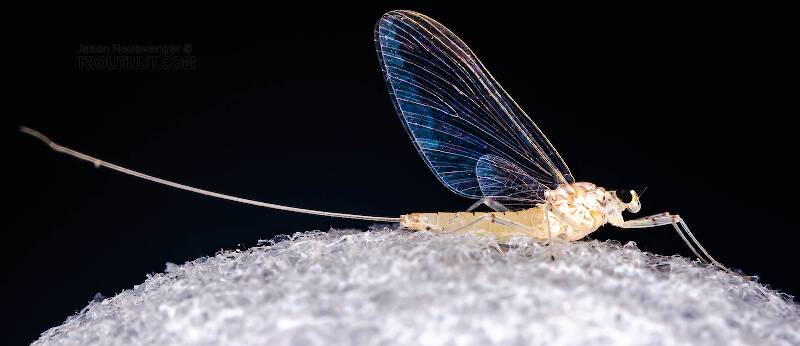
1 Nymph
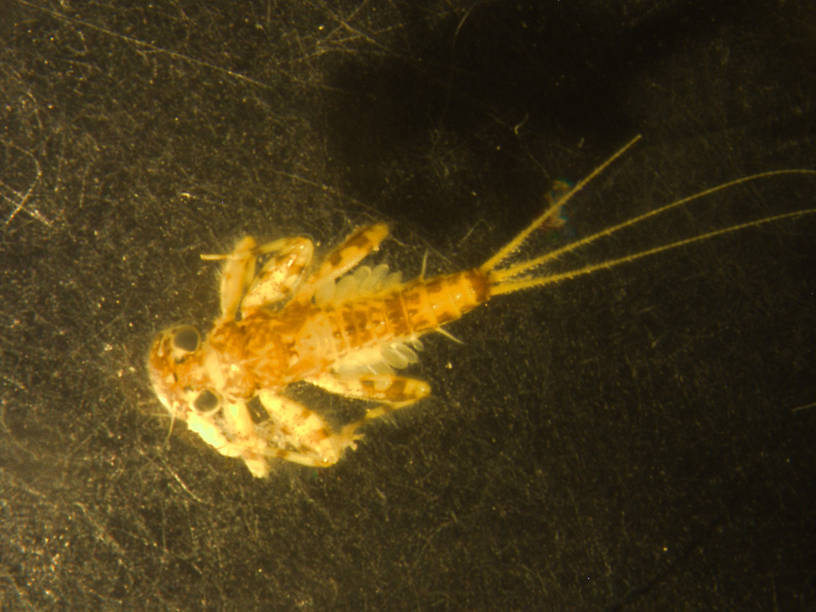
Discussions of Stenonema terminatum
Start a Discussion of Stenonema terminatum
References
- Needham, James G., Jay R. Traver, and Yin-Chi Hsu. 1935. The Biology of Mayflies. Comstock Publishing Company, Inc.
Mayfly Species Stenonema terminatum
Species Range
Resources
- NatureServe
- Integrated Taxonomic Information System
- Global Biodiversity Information Facility
- Described by Walsh (1862)

